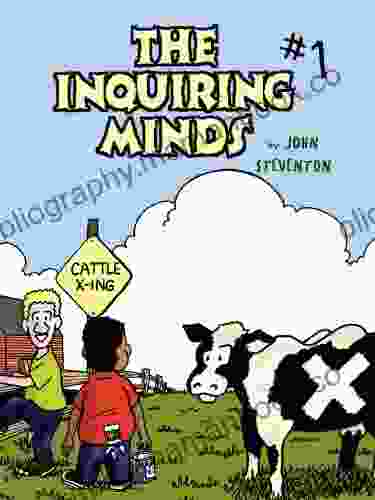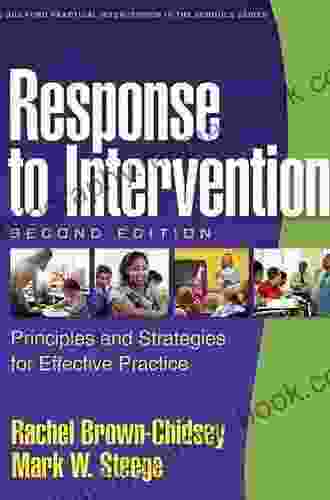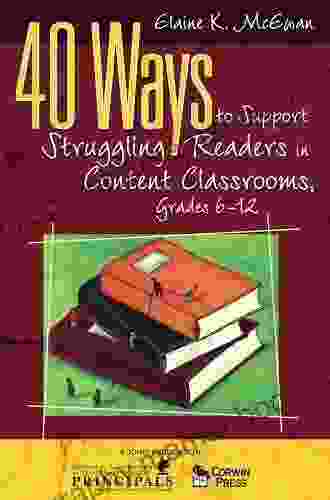40 Ways to Support Struggling Readers in Content Classrooms, Grades 1-2

4.1 out of 5
| Language | : | English |
| File size | : | 3819 KB |
| Text-to-Speech | : | Enabled |
| Screen Reader | : | Supported |
| Enhanced typesetting | : | Enabled |
| Word Wise | : | Enabled |
| Print length | : | 198 pages |
Every teacher has students who struggle with reading. In content classrooms, this can be especially challenging, as students are expected to read and comprehend complex texts in order to access the curriculum.
There are many things that teachers can do to support struggling readers in their classrooms. Here are 40 proven strategies:
1. Use multisensory activities
Struggling readers often benefit from multisensory activities that engage their senses of sight, sound, touch, and movement.
- Try these activities:
- Have students trace letters and words in sand or shaving cream.
- Use tactile letters or magnetic letters to build words.
- Play rhyming games or sound games.
- Have students act out stories or passages.
2. Provide explicit phonics instruction
Phonics is the relationship between letters and sounds. Explicit phonics instruction teaches students the rules of phonics in a systematic way.
Here are some tips for providing explicit phonics instruction:
- Start with the basics: letter recognition, letter sounds, and blending.
- Use a phonics program that is research-based and systematic.
- Provide plenty of practice opportunities.
- Be patient and supportive.
3. Teach decoding skills
Decoding is the process of figuring out how to pronounce words. Decoding skills are essential for reading fluency.
Here are some tips for teaching decoding skills:
- Use decodable texts that are written with words that students can sound out.
- Provide students with strategies for decoding unfamiliar words.
- Have students practice decoding words in isolation and in context.
- Be patient and supportive.
4. Build fluency
Fluency is the ability to read smoothly, accurately, and with expression. Struggling readers often have difficulty with fluency.
Here are some tips for building fluency:
- Have students practice reading aloud regularly.
- Use choral reading or partner reading to help students build confidence.
- Provide students with scaffolded reading opportunities, such as reading along with an audio recording.
- Be patient and supportive.
5. Develop vocabulary
Vocabulary is the knowledge of words and their meanings. Struggling readers often have limited vocabularies.
Here are some tips for developing vocabulary:
- Expose students to new words regularly through reading, writing, and conversation.
- Use visuals, such as pictures, gestures, or real objects, to help students understand the meaning of new words.
- Provide students with multiple exposures to new words in different contexts.
- Be patient and supportive.
6. Motivate struggling readers
Struggling readers often lack motivation to read. It is important to find ways to motivate these students.
Here are some tips for motivating struggling readers:
- Choose books that are interesting and engaging for students.
- Make reading a social activity by reading aloud to students or having them read to a partner.
- Set realistic goals for students and celebrate their successes.
- Provide students with choices in their reading materials.
- Be patient and supportive.
7. Engage students
Struggling readers need to be engaged in order to learn. Find ways to make reading fun and motivating.
Here are some tips for engaging students:
- Use technology to make reading more interactive.
- Incorporate games and activities into your reading instruction.
- Provide students with opportunities to share their reading with others.
- Be patient and supportive.
8. Differentiate instruction
Differentiated instruction is the process of tailoring instruction to the needs of individual students. This means providing students with different levels of support, different types of activities, and different materials.
Here are some tips for differentiating instruction for struggling readers:
- Assess students' reading abilities and needs.
- Provide students with different levels of support, such as scaffolding, guided reading, or independent reading.
- Use different types of activities to meet the needs of different learners.
- Provide students with different materials, such as leveled texts, audiobooks, or graphic novels.
- Be patient and supportive.
9. Provide scaffolding
Scaffolding is a temporary support system that helps students learn new skills. As students become more proficient, the scaffolding can be gradually removed.
Here are some tips for providing scaffolding for struggling readers:
- Provide students with visual aids, such as charts, diagrams, or pictures.
- Use graphic organizers to help students organize their thoughts.
- Read aloud to students or have them read along with an audio recording.
- Provide students with sentence starters or story starters.
- Be patient and supportive.
10. Provide accommodations and modifications
Accommodations and modifications are changes to the curriculum or instruction that help students with disabilities access the general education curriculum.
Here are some accommodations and modifications that can be helpful for struggling readers:
- Provide students with extended time on tests and assignments.
- Allow students to use audiobooks or assistive technology.
- Modify assignments to make them more accessible for students with disabilities.
- Provide students with preferential seating or other accommodations to help them focus.
- Be patient and supportive.
Supporting struggling readers in content classrooms can be challenging, but it is possible. By using a variety of strategies, teachers can help these students develop the skills they need to become successful readers.
It is important to remember that every student is different. What works for one student may not work for another. It is important to be patient and supportive, and to find the strategies that best meet the needs of each individual student.
4.1 out of 5
| Language | : | English |
| File size | : | 3819 KB |
| Text-to-Speech | : | Enabled |
| Screen Reader | : | Supported |
| Enhanced typesetting | : | Enabled |
| Word Wise | : | Enabled |
| Print length | : | 198 pages |
Do you want to contribute by writing guest posts on this blog?
Please contact us and send us a resume of previous articles that you have written.
 Top Book
Top Book Novel
Novel Fiction
Fiction Nonfiction
Nonfiction Literature
Literature Paperback
Paperback Hardcover
Hardcover E-book
E-book Audiobook
Audiobook Bestseller
Bestseller Classic
Classic Mystery
Mystery Thriller
Thriller Romance
Romance Fantasy
Fantasy Science Fiction
Science Fiction Biography
Biography Memoir
Memoir Autobiography
Autobiography Poetry
Poetry Drama
Drama Historical Fiction
Historical Fiction Self-help
Self-help Young Adult
Young Adult Childrens Books
Childrens Books Graphic Novel
Graphic Novel Anthology
Anthology Series
Series Encyclopedia
Encyclopedia Reference
Reference Guidebook
Guidebook Textbook
Textbook Workbook
Workbook Journal
Journal Diary
Diary Manuscript
Manuscript Folio
Folio Pulp Fiction
Pulp Fiction Short Stories
Short Stories Fairy Tales
Fairy Tales Fables
Fables Mythology
Mythology Philosophy
Philosophy Religion
Religion Spirituality
Spirituality Essays
Essays Critique
Critique Commentary
Commentary Glossary
Glossary Bibliography
Bibliography Index
Index Table of Contents
Table of Contents Preface
Preface Introduction
Introduction Foreword
Foreword Afterword
Afterword Appendices
Appendices Annotations
Annotations Footnotes
Footnotes Epilogue
Epilogue Prologue
Prologue Daniel Garrison Brinton
Daniel Garrison Brinton Peggy L Henderson
Peggy L Henderson Lee A Westberry
Lee A Westberry Ken Little
Ken Little Michael Chiarello
Michael Chiarello Martin Wolf
Martin Wolf Kathy T Glass
Kathy T Glass Jan Philipp Sendker
Jan Philipp Sendker Ginny Owens
Ginny Owens Eldridge Kalford
Eldridge Kalford Aaron Tucker
Aaron Tucker Anna Castor
Anna Castor Marneen L Fields
Marneen L Fields Anthony Bourdain
Anthony Bourdain Brian Carr
Brian Carr Hampton Sides
Hampton Sides From Hell
From Hell Salman Rushdie
Salman Rushdie Amy Ratcliffe
Amy Ratcliffe Gail Z Martin
Gail Z Martin
Light bulbAdvertise smarter! Our strategic ad space ensures maximum exposure. Reserve your spot today!

 W.B. YeatsImmortals' Runes: Ednah Walters' Enchanting Saga of Ancient Power and Astral...
W.B. YeatsImmortals' Runes: Ednah Walters' Enchanting Saga of Ancient Power and Astral...
 William WordsworthThe Enduring Charm of Chrysler's Classic Designs in the Modern Age: A...
William WordsworthThe Enduring Charm of Chrysler's Classic Designs in the Modern Age: A...
 Natsume SōsekiThe Inquiring Minds of Cattle: Unlocking the Cognitive Capabilities of Our...
Natsume SōsekiThe Inquiring Minds of Cattle: Unlocking the Cognitive Capabilities of Our... Felipe BlairFollow ·6k
Felipe BlairFollow ·6k James GrayFollow ·14.1k
James GrayFollow ·14.1k Bob CooperFollow ·5.7k
Bob CooperFollow ·5.7k Henry David ThoreauFollow ·19.6k
Henry David ThoreauFollow ·19.6k Caleb LongFollow ·14.7k
Caleb LongFollow ·14.7k Edgar Allan PoeFollow ·18.1k
Edgar Allan PoeFollow ·18.1k Arthur C. ClarkeFollow ·6.9k
Arthur C. ClarkeFollow ·6.9k Jett PowellFollow ·12.5k
Jett PowellFollow ·12.5k

 Patrick Rothfuss
Patrick RothfussHow to Make a Million Dollars: No Secrets
Making a million dollars...

 Robert Heinlein
Robert HeinleinResponse to Intervention, Second Edition: RTI in Practice
A Comprehensive Resource for Educators and...

 Timothy Ward
Timothy WardUnravel the Gripping Assassination Thriller Bursting with...
Prepare yourself for a...
4.1 out of 5
| Language | : | English |
| File size | : | 3819 KB |
| Text-to-Speech | : | Enabled |
| Screen Reader | : | Supported |
| Enhanced typesetting | : | Enabled |
| Word Wise | : | Enabled |
| Print length | : | 198 pages |












